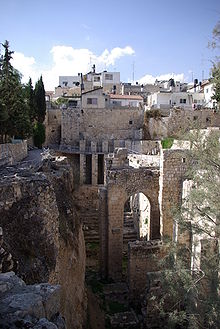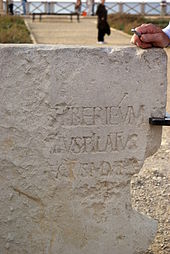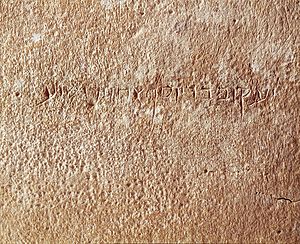- Christian archaeology
-
Christian Archeology (more commonly termed "Biblical Archaeology") is the study of archaeological sites in connection to the texts of the Bible. The abundance of forgeries, fakes, and misinterpretations is rife, and as such the verification of context and the maintenance of an unbiased standpoint is essential. It is an auxiliary of history and has played an important role in the quest for the historical Jesus and an attempt to establish the historicity of Christ.[1]
Contents
Pool of Bethesda
According to the Gospel of John, the Pool of Bethesda was a swimming bath (Greek: kolumbethra) with five porticos (translated as porches by older English bible translations).[2][3] The Johannine narrative describes the porticos as being a place in which large numbers of infirm people were waiting, which corresponds well with the site's 1st century CE use as an asclepieion. The biblical narrative describes a Shabbat visit to the site by Jesus, during which he heals a man who has been bedridden for many years, and could not make his own way into the pool.[4] Prior to archaeological digs, the Pool of Bethesda was identified with the modern so-called Fountain of the Virgin, in the Kidron Valley, not far from the Pool of Siloam, and alternately with the Birket Israel, a pool near the mouth of the valley which runs into the Kidron south of St. Stephen's Gate.
In digs conducted in the 19th century, Schick discovered a large tank situated about 100 feet north-west of St. Anne's Church, which he contended was the Pool of Bethesda. Further archaeological excavation in the area, in 1964, discovered the remains of the Byzantine and Crusader churches, Hadrian's Temple of Asclepius and Serapis, the small healing pools of the Asclepieion, the other of the two large pools, and the dam between them.[5] It was discovered that the Byzantine construction was built in the very heart of Hadrian's construction, and contained the healing pools.[5][6]
This archaeological discovery proved beyond a doubt that the description of this pool in the Gospel of John was not the creation of the Evangelist, but instead reflected an accurate and detailed knowledge of the site. The Gospel speaks of the name of the pool as Bethesda, its location near the Sheep Gate; and the fact that it has five porticos; with rushing water. These details are corroborated through literary and archaeological evidence affirming the historical accuracy of the Johannine account.[7]
Caiaphas ossuary
German higher-critical scholars in the 18th and 19th centuries questioned historicity of Caiaphas. By the 20th century Jesus myth theory argued he was merely fictional character having no basis in historical fact. In 1990 an ornate limestone ossuary was discovered in the Abu Tor neighborhood of modern Jerusalem.[8][9]
This ossuary appeared authentic and contained human remains. The Aramaic inscription on the side which read "Joseph son of Caiaphas." also appeared authentic. The bones in the ossuary were of an elderly man. According to the New York Times and a number of Biblical scholars, if the remains are proven to be those of Caiaphas, it will be an important confirmation of the New Testament account, and lead to greater understanding of the historical Jesus.
If true, the discovery would be an important confirmation of a significant segment of the New Testament account of Jesus leading to a greater understanding of the historical Jesus.[8][9][10]
Since the original discovery, the identification with Caiaphas has been challenged by some scholars on various grounds, including the spelling of the inscription, the lack of any mention of Caiaphas's status as High Priest, the plainness of the tomb (although the ossuary itself is as ornate as might be expected from someone of his rank and family), and other reasons.[11]Bond, Helen Katharine (2004). Caiaphas: friend of Rome and judge of Jesus?. Westminster/John Knox Press. pp. 4–8. ISBN 978-0664223328. http://books.google.co.uk/books?id=TRGpNmDmfxAC&pg=PA7&dq=family+tomb+of+Caiaphas&hl=en&ei=i9y-TJ2DE8WD4QaQjvzUAQ&sa=X&oi=book_result&ct=result&resnum=1&ved=0CCgQ6AEwAA#v=onepage&q=family%20tomb%20of%20Caiaphas&f=false.</ref>
Pilate Stone
The Pilate Stone is the name given to a block of limestone with a carved inscription attributed to Pontius Pilate, a prefect of the Roman-controlled province of Judaea from 26-36. The stone was found in 1961 by a team of Italian archeologists and is significant because this is the only universally accepted archaeological find with an inscription mentioning the name "Pontius Pilatus" to date.
The 82 cm x 65 cm limestone block, was found in 1961 in an excavation of an ancient theater (built by decree of Herod the Great c. 30 BC), called Caesarea Maritima in the present-day city of Caesarea-on-the-Sea (also called Maritima). On the partially damaged block is a dedication to Tiberius Caesar Augustus. It has been deemed authentic because it was discovered in the coastal town of Caesarea, which was the capital of Iudaea Province[12] during the time Pontius Pilate was Roman governor.
The partial inscription reads (conjectural letters in brackets):
- [DIS AUGUSTI]S TIBERIEUM
- [PO]NTIUS PILATUS
- [PRAEF]ECTUS IUDA[EA]E
- [FECIT D]E[DICAVIT]
The translation from Latin to English for the inscription reads: Pontius Pilate, prefect of Judea, has restored the Tiberieum of the Seaman (or possibly, of the Caesareans) .[13]
James Ossuary
 The James ossuary was on display at the Royal Ontario Museum from November 15, 2002 to January 5, 2003.
The James ossuary was on display at the Royal Ontario Museum from November 15, 2002 to January 5, 2003.
The James Ossuary is a 2,000-year old limestone box used as a container for the bones of the deceased. Antiquities dealer, and convicted forgoer Oded Golan is believed to have discovered the James Ossuary at some point before 2003 on the illegal Israeli antiquities marker. The Aramaic inscription on the artifact reads: Ya'akov bar-Yosef akhui diYeshua, "James, son of Joseph, brother of Jesus."
While the age of the Ossuary is not contested, the inscription has been declared a modern forgery by the Israel Geological Survey based on examination of the patina covering the box itself and the inscription.
Papyrus Fragments
Papyrus is a primitive form of paper produced from the pith of the papyrus plant, a wetland sedge that was once abundant in the Nile Delta of Egypt. Papyrus was in common use in the Roman Empire during the 1st century CE. Sheets of papyrus were glued together to produce a scroll of approximately 30 feet.
Archeologists have discovered many papyrus fragments. In studying these fragments, they noticed that the material, ink, glue, script, punctuation, writing style, language, etc., was slowly evolving.
Just as a book printed at the time of H.G. Wells is easy to distinguish by the trained eye from a book published in 2000 AD, so too can the trained papyrologists distinguish the subtleties of different fragments and date them reasonably accurately (generally within a thirty-year window).
An example of this took place recently and created quite a stir among Biblical Scholars .[citation needed] While analyzing a fragment of the Gospel of Matthew, Dr. Carson Theide of the Paterborn Institute found the sample to be identical to another fragment found at Qumran .[citation needed] Furthermore, it matched a second legal document .[citation needed] This legal document was dated[citation needed], while the fragment from Qumran was known to be written around 65 AD .[citation needed] (in any event, before the community was destroyed by the Romans in 68 AD).
Thus, Theide had two dated documents from the 60s that have the same ‘time signature’ as the Canonical Matthean fragment .[citation needed] Therefore, he argues that we know that the Canonical Matthean Gospel was written in 65 AD. (+ or – 15 years).[citation needed]
Biblical scholarship has shown that the fragment Theide used was of a much later version of the Canonical Matthean Gospel .[citation needed] Therefore, the original of the Matthean Gospel was composed in 55 AD. (+ or – 15 years) .[citation needed]
Biblical scholarship has proved that the writer of Matthew based his work on three earlier documents (M source, Mark, and Q source).[citation needed] Therefore, the three primary source documents for the Canonical Matthean Gospel would have been written between 40 and 55 AD. (+ or – 15 years).[citation needed] Yet the debate has just begun and the dating of Matthew is far from being resolved. (See Markan priority)
The Oxyrhynchus Papyri
The Oxyrhynchus Papyri date from between the 2nd and 6th century. The fragments were discovered in the late 19th century at Oxyrhynchus, Egypt. Surviving fragments of the Gospel of Thomas and other New Testament canon and Apocrypha discovered among the fragments date from the 2nd and 3rd century's, and may represent a portion of an earlier collection of sayings attributed to Jesus.[citation needed]
Papyrologists believe these sayings of Jesus were recorded earlier rather than later (some fragments from Oxy. 1224 may be from 40 AD.).[citation needed] Others[who?] have linked these papyri to the Gospel of the Hebrews. The Oxyrhynchus Papyri are of significance to biblical scholars as they offer some of the earliest autographs of New Testament canon and Apocrypha.
Papyrus Egerton 2
The Egerton Gospel (British Library Egerton Papyrus 2) refers to a group of papyrus fragments of a codex of a previously unknown gospel, found in Egypt and sold to the British Museum in 1934; the physical fragments are now dated to the very end of the 2nd century AD, although the date of composition is less clear - perhaps 50-100 AD. It is one of the oldest known fragments of any gospel, or any codex. It is also called the Unknown Gospel, as no known ancient source makes reference to it, in addition to being entirely unknown before its publication.
Despite its apparent historical importance, the text is not well known. It is a mere fragment, and does not bear a clear relationship to any of the four canonical gospels. The sayings included in this "Unknown Gospel" are the type of traditional sayings are posited for the hypothetical Q Document. Ronald Cameron states: "Since Papyrus Egerton 2 displays no dependence upon the gospels of the New Testament, its earliest possible date of composition would be sometime in the middle of the first century, when the sayings and stories which underlie the New Testament first began to be produced in written form. The latest possible date would be early in the second century, shortly before the copy of the extant papyrus fragment was made. Because this papyrus presents traditions in a less developed form than John does, it was probably composed in the second half of the first century, in Syria, shortly before the Gospel of John was written."
The Fayyum Papyrus
The Fayyum Fragment(Papyrus Vindobonensis Greek 2325 [P. Vienna G. 2325]) is a papyrus fragment containing text that could be from part of the New Testament. The surviving manuscript is badly damaged and has fewer than a hundred Greek letters preserved. Because of its style of handwriting it is believed to have been copied around the end of the 3rd century. The text seems to parallel Mark 14:26-31, appearing to present a more abbreviated account. It is unclear whether the fragment is an abridged version of the synoptic gospels, or a source text on which they were based, perhaps the apocryphal Gospel of Peter.[3]
The text reads:
Papyrus Vindobonensis 2325[14] ...ε]ξαγειν ως ε[ι]πε[ν] οτι, Α[παντες][εν ταυτη] τη νυκτι σκανδαλισ[θησεσ-][θε κατα] το γραφεν· Παταξω τον [ποιμε-][να, και τα] προβατα διασκορπισθησ[ονται. ει-][ποντος το]υ Πετ{ρου}· Και ει παντες, ο[υκ εγω....][...Ι{ησου}ς· Πρι]ν αλεκτρυων δις κοκ[κυσει τρις][...με α]παρν[ηση.]...l]ead out, when he s[a]i[d]: A[ll]of you [on this] night will be scandaliz[ed][according to] what is written: I shall strike the [shep-]herd and the] sheep shall be scatter[ed. When][said] Pet{er}: Even if all, n[ot I....][...J{esu}s: Befor]e a cock twice cr[ows, thrice][you will d]en[y me].References
- ^ Charles Wesley Bennett, Christian archaeology, Volume 4, Phillips & Hunt, 1888. p 13
- ^ John 5:2
- ^ Peake's commentary on the Bible (1962), on John 5:1-18
- ^ John 5:1-18
- ^ a b > An archaeological diagram of the layout - the diagram displayed at the location itself - is visible at this link
- ^ James H. Charlesworth 2006. p 560-566
- ^ James H. Charlesworth, Jesus and archaeology, Wm. B. Eerdmans Publishing, 2006. p 566
- ^ a b The Caiaphas Ossuary Great archaeology, 2010. p 1
- ^ a b "Tomb May Hold the Bones Of Priest Who Judged Jesus"
- ^ James H. Charlesworth, Jesus and archaeology, Wm. B. Eerdmans Publishing, 2006. pp 323-329
- ^ James H. Charlesworth 2006. pp 323-329
- ^ A History of the Jewish People, H.H. Ben-Sasson editor, 1976, page 247: "When Judea was converted into a Roman province [in 6 CE, page 246], Jerusalem ceased to be the administrative capital of the country. The Romans moved the governmental residence and military headquarters to Caesarea. The centre of government was thus removed from Jerusalem, and the administration became increasingly based on inhabitants of the hellenistic cities (Sebaste, Caesarea and others)."
- ^ Craig A. Evans, The Bible knowledge background commentary, Volume 3, Cook Publishing, 2005. p 151
- ^ Gospel Parallels, A Comparison of the Synoptic Gospels, 5th ed. Burton H. Throckmorton, Jr. editor. (Nashville: Thomas Nelson, 1992). ISBN 0-840-77484-2
External links
- Pontificio Istituto di Archeologia Cristiana.
- Excavation Sites Archaeological work and volunteer pages.
- Archaeology in Popular Culture
- Anthropology Resources on the Internet - Anthropology Resources on the Internet : a web directory with over 3000 links grouped in specialised topics.
- Archaeology magazine published by the Archaeological Institute of America
- Archaeology Directory - Directory of archaeological topics on the web.
- The 2003- Iraq War & Archaeology Information about looting in Iraq.
 "Christian Archaeology". Catholic Encyclopedia. New York: Robert Appleton Company. 1913.
"Christian Archaeology". Catholic Encyclopedia. New York: Robert Appleton Company. 1913.
Further reading
- Ashmore, W. and Sharer, R. J., Discovering Our Past: A Brief Introduction to Archaeology Mountain View: Mayfield Publishing Company. ISBN 0-7674-1196-X. This has also been used as a source.
- Neumann, Thomas W. and Robert M. Sanford, Practicing Archaeology: A Training Manual for Cultural Resources Archaeology Rowman and Littlefield Pub Inc, August, 2001, hardcover, 450 pages, ISBN 0-7591-0094-2
- Renfrew, Colin & Bahn, Paul G., Archaeology: Theories, Methods and Practice, Thames and Hudson, 4th edition, 2004. ISBN 0-500-28441-5
- Sanford, Robert M. and Thomas W. Neumann, Cultural Resources Archaeology: An Introduction, Rowman and Littlefield Pub Inc, December, 2001, trade paperback, 256 pages, ISBN 0-7591-0095-0
- Trigger, Bruce. 1990. "A History of Archaeological Thought". Cambridge: Cambridge University Press. ISBN 0-521-33818-2
- Frend, William Hugh Clifford, The Archaeology of Early Christianity. A History, Geoffrey Chapman, 1997. ISBN 0-225-66850-5
Wikimedia Foundation. 2010.



